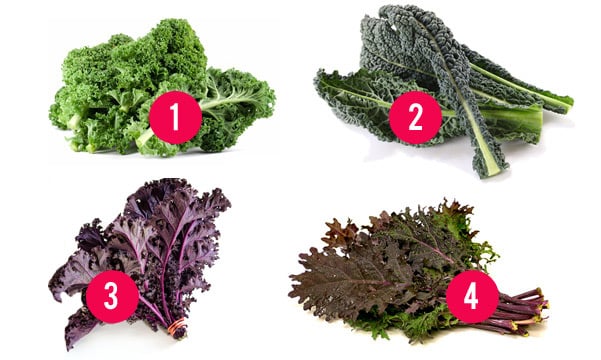Medically review by Kim Langdon

Learn the kale facts: different types of kale, nutritional benefits, and how to use this amazing cruciferous green vegetable with our handy reference guide.
Kale has become the darling vegetable of the nutrition world.
It is part of the Brassica group, which includes other cruciferous vegetables such as cabbages, cauliflower, Brussels sprouts, and broccoli.
Kale has gorgeous - sometimes very curly - leaves that have a unique earthy, and slightly bitter, flavor to them, with tough fibrous stems.

Kale health benefits
When you see some of the stats on kale, it is very easy to see why it has become so popular!
Kale provides a nutrient-dense hit every time.
It is packed with beneficial fiber, vitamin C, vitamin A, vitamin K and magnesium.
Kale is also a rich source of antioxidant polyphenols (at least 45 different polyphenols), ranking higher than other Brassica vegetables.
Polyphenols' different protective properties are known for their protection against the effects of aging and also oxidative stress.
Anti-aging and antioxidant?
Kale and eye health
Kale contains the carotenoids lutein and zeaxanthin, along with fantastic levels of beta-carotene which are all essential for good eye health and the prevention of eye conditions such as cataracts and macular degeneration.
Kale and preventative health
Kale, along with other cruciferous family members, contains glucosinolates which are then converted to compounds such as isothiocyanates, thiocyanates, and indoles.
Regular consumption of kale and other cruciferous vegetables, to obtain adequate levels glucosinolates is associated with a reduced incidence of cancer.
Be aware
Types of kale

1. Curly kale – probably the most common type of kale that can be found in most supermarkets and green grocers.
It has a pungent, almost peppery flavor that is very pleasant to the palate but if you prefer less bitterness, look for younger kale as leaves have a milder taste.
2. Lacinto kale – another popular type of kale also known as Tuscan kale or Tuscan cabbage (cavolo nero) or Dinosaur kale.
It's leaves are narrow, dark green and wrinkly attached to a hard stem that should ideally be removed. It’s flavorsome and mildly astringent.
3. Redbor kale – this is a very pretty looking kale with ruffled leaves ranging from deep red to purple color, sometimes with some shades of green.
As well as cooking, Redbor kale is also used for its ornamental qualities in the garden and for garnishes.
4. Russian (Siberian) kale – this type of kale is harder to find but is equally beneficial and delicious, with flat, fringed leaves that look like large rocket/arugula leaves and range from green to red/purple shades.
It’s sweet and mild with traces of pepper and can be cooked in the same way as the other types of kale.
What is the difference between green kale and red kale?
The primary difference between the two is in the way they taste. Red Russian kale is said to have a much sweeter and delicate flavor compared to green kale.
Therefore, sometimes it's an easier option to get your taste buds introduced.
Red kale nutrition is almost identical and both are great options for a nutrient-dense green leafy vegetable, packed with vitamin K, vitamin C and other antioxidants.
Where to Buy Good Kale
Fresh: From farmers' markets or supermarkets and - when possible - buy organic and local.
Be on the lookout for nice dark, green-colored leaves and moist (not hard and woody) stems. Kale is also relatively easy to grow if you have a little patch of soil.
Supplement form: You can get kale in a powdered capsule form, usually in combination with other dried greens.
As always, we do not recommend you start any new supplement without consulting your primary health care professional first.
How to use kale
Kale supplements
Here at Happy Body Formula, we strongly believe in food as medicine and the power of real food.
Because of this, we prefer to get the ‘good stuff’ in its whole form when possible.
It is better to eat a wide range of seasonal vegetables and fruits to ensure you are getting a good range of nutrients.
If you have trouble taking in greens, a good green powder supplement can help.
We like Nested Naturals Super Greens powder. Overconsumption of one particular food can lead to nutrient excess, which can be just as detrimental to your health as nutrient deficiencies.
What is your favorite way to use kale? We love this simple kale salad recipe. Share with us below!
This article was fact checked for accuracy by Dr. Kim Langdon, MD. As always, this is not personal medical advice and we recommend that you talk with your doctor.
References
Kimberly Langdon M.D. is a retired University-trained obstetrician/gynecologist with 19-years of clinical experience. She delivered over 2000 babies to mothers in a suburban Midwestern community.


Thank you for an educational retreat in kale. After being diagnosed with heart failure, cardiomegally including cardiomyapathy my diet was transformed to stay alive. I’ve found kale to be one of the best food that cleanses and oxidize immediately. I was put on a low cal diet before the cardiac arrest. Abosolutely no fried foods, no meat, no cholesterol is mandatory to live. In this condition can you suggest something else that I can eat. The truth I am getting tired of kale. Thank you.
Other leafy greens and non-starchy veggies will be great for you, so switch it up with some watercress and spinach, and add in some other crucifers like brussels sprouts, cabbage, broccoli and cauliflower.